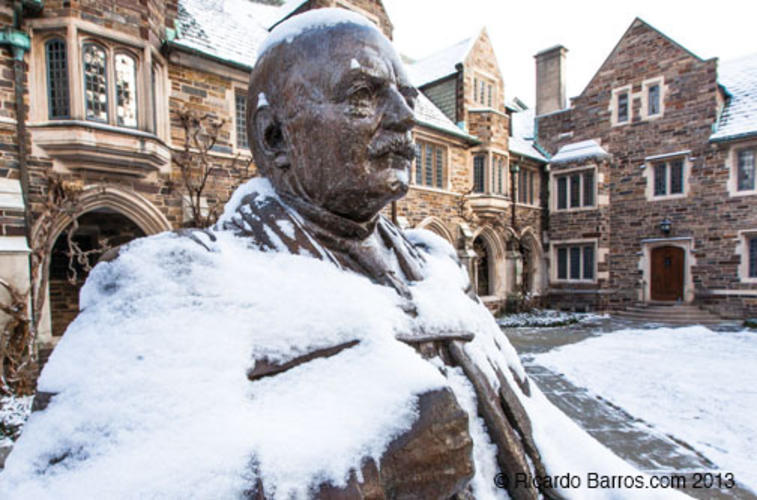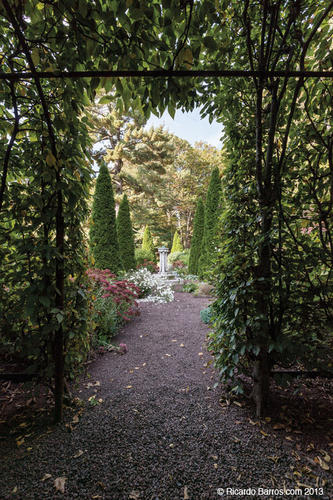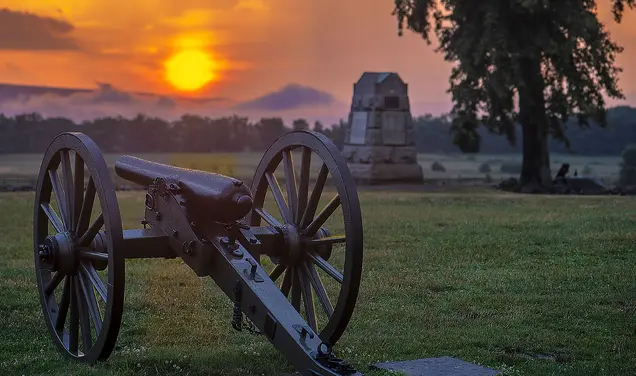
Away From the Horde
Dean Andrew Fleming West won his famous feud with Woodrow Wilson a century ago. The result was a college of uncommon beauty.
A century ago, the sun blazed upon the dedication of Princeton’s Graduate College. Vivid with pomp and heraldry, that three-day gala in October 1913 marked a triumph for Dean Andrew Fleming West 1874, who had fought hard for the creation of this stunning neo-medieval complex and successfully urged that it be built on the golf links, a half-mile from Princeton’s undergraduate campus.
Photographs by Ricardo Barros | Text by W. Barksdale Maynard ’88
William Howard Taft, the former U.S. president and recent campaign rival to Woodrow Wilson 1879, gave the keynote speech — an emotional tribute to Grover Cleveland, a Princeton resident who was honored by the college’s 173-foot-tall Cleveland Memorial Tower. As Leopold Stokowski’s Philadelphia Orchestra played “The Star-Spangled Banner,” young Richard Cleveland ’19 pulled a halyard to unfurl an American flag atop the tower, the same one that had flown over the White House in his father’s day.
One of the most beautiful complexes ever built on an American campus, the Graduate College emerged from that infamous academic feud, West versus Wilson. The fight had erupted over the allied questions: Who should control the Graduate College? Where should it be located?The sometimes imperious Wilson, previously Princeton’s president, had wanted it firmly under his rule, and he wanted it on campus, where graduate students would inspire undergraduates daily. But his nemesis West favored a distant site where he could create a cohesive community of graduate scholars, leading a high-minded and stimulating life free from the undergraduate horde.
West proved a canny fundraiser, undermining Wilson’s intellectual arguments with cold cash donated by well-to-do alumni, including William Cooper Procter 1883, head of Procter & Gamble, who had grown rich on Ivory soap. The trustees came down on the side of capital. Wilson, disgusted, left Princeton for politics and was in the White House the day the Graduate College was dedicated. When it opened, it housed 102 students in grand suites; today, after an expansion in the 1920s and construction of the “new GC” in the 1960s, it can accommodate about 430. A century after its opening, the Graduate College’s remote location remains unpopular with some, but no one denies that its Gothic architecture is timeless and sublime.
W. Barksdale Maynard ’88 is a lecturer at the University and author of Princeton: America’s Campus, recently named to a state list of 101 great New Jersey books.
Endlessly picturesque, the Graduate College marks one of the triumphs of medieval revivalism in the United States, a movement Princeton had helped pioneer with Blair Hall in the 1890s. The Graduate College is the enduring masterpiece of Ralph Adams Cram, supervising architect of the campus and the greatest American advocate for Gothic style. “Here is the most that architecture, as an art of expression, is capable of attaining,” the magazine Architectural Record exulted. Hand-carved details from moldings to gargoyles were derived from English medieval universities. Even the ground plan was irregular, as if the college truly were ancient.
A bustling, officious man of definite ideas, Dean Andrew Fleming West partnered with Cram in creating the Oxford-like look of the Graduate College, which inspired subsequent Gothic campuses at Duke and Yale, an aestheticism that sputtered out with the Depression. West looked back in 1930 with pride at his college of “extraordinary beauty and distinction. The sylvan loveliness of its academic shades is a constant part of our life.” Since 1928 West has been enthroned in bronze in the main courtyard of the Graduate College, in this statue by R. Tait McKenzie.
Perhaps the loveliest interior in all of Princeton, 100-foot-long Procter Hall (top) is worthy of a medieval castle. For decades, students dining here were required to wear academic robes. West, clad in his red Oxford gown, used a secret side door to slip back and forth from adjacent Wyman House — the half-timbered deanery — to the raised dais where the faculty ate at high table beneath an enormous stained-glass window. The hall is roofed with hammerbeam trusses carved from old ship timbers and adorned with humorous carved portrait heads, said to represent the trustees, including one of donor Procter holding a bar of Ivory soap, at top.
Lush plantings throughout the Graduate College were designed by Beatrix Farrand, consulting landscape gardener to the University. Her signature here was espalier: securing trees and shrubs against walls with wire and bolts. Thus did she keep the courtyards open for scurrying students and avoid shading already dark Gothic rooms. “Farrand selected things for when students would be here — often a kind of yellow-green,” says architect Michael Graves, an admirer of her work. “There isn’t anything, not even Luxembourg Gardens, as delicate as Princeton.” Wyman House has a private garden, above.
Atop the Cleveland Memorial Tower, 137 steps high, is Princeton’s tuneful carillon. The gift of the Class of 1892 back in 1927, the carillon of stationary bronze bells is one of just four in New Jersey still played on a traditional keyboard – the keys resembling broom handles that one thumps with a fist. After decades of disuse, the carillon was refurbished 20 years ago, when bells were added. Now with 67 bells — some big enough for several people to stand inside — it is the fifth-largest of the 182 traditional carillons in North America, and musically one of the finest in the world.
Click here to watch a YouTube video of musicians playing the carillon.
Princeton is holding its first conference for graduate alumni from all departments, Many Minds, Many Stripes, Oct. 17–19. For information, visit alumni.princeton.edu/manyminds.















2 Responses
Norman Cliff *57
9 Years AgoLife in the G.C.
Your article on the Graduate College (feature, Sept. 18) brought back some memories. Dean West 1874 definitely succeeded in separating graduate students from undergraduates. We grads had virtually no contact with undergrads unless we were teaching a precept or were a lab assistant. Undergrads called the G.C. “Goon Castle,” and the best we could do in reply was to refer to them as “Tigers.”
We were, in truth, a rather nerdy bunch. Dean West’s expectation of spirited intellectual discussions in the lounge would have been largely disappointed. There was very little in the way of social interaction except a few departmental parties, although some close friendships were formed.
We mostly stuck to our books and labs. The G.C. catacombs contained one TV, one Ping-Pong table, and one pool table. The photo of the statue of Dean West reminded me of the occasional game of “dean ball.” A ball was thrown at the statue, and players bet on which area it would rebound into. If a golf ball was used, the statue would give off a very satisfying “bong.”
There were, of course, no women students at all. Another anachronism was that about 1953, the then-dean decreed that academic gowns would be worn at dinner. The issue was put to a vote by enterprising students, and was overwhelmingly voted down. The dean said, “There are some things on which you do not vote,” and we, the Silent Generation, went back to our labs and books and gowns at dinner. Gowns did turn out to be a convenience. One could wear anything — or nothing — under them, and no one cared if they were stained.
Brooks Wrampelmeier ’56
9 Years AgoMeeting with Grad Students
Norman Cliff *57, in his letter (Inbox, Nov. 13) about life at the graduate school in the mid-1950s, states that there was virtually no contact between graduate and undergraduate students. My own experience, as an undergraduate majoring in Arabic, was somewhat different.
Perhaps because the old Oriental Languages and Literatures Department was fairly small, I had almost daily contact with graduate students also using the OLL research room at Firestone Library. I recall being invited by one grad student to dinner at the G.C. (and yes, I was required to wear a badly stained gown for the occasion). As a senior I attended at least one drinks party at the G.C. Years later, I encountered some of my grad-school acquaintances in Lebanon and at conferences of the Middle East Studies Association of North America. One became my supervisor in 1968 while I was research analyst for Egypt in the Department of State.
In short, I benefited greatly from the opportunities to interact academically and socially with graduate students.